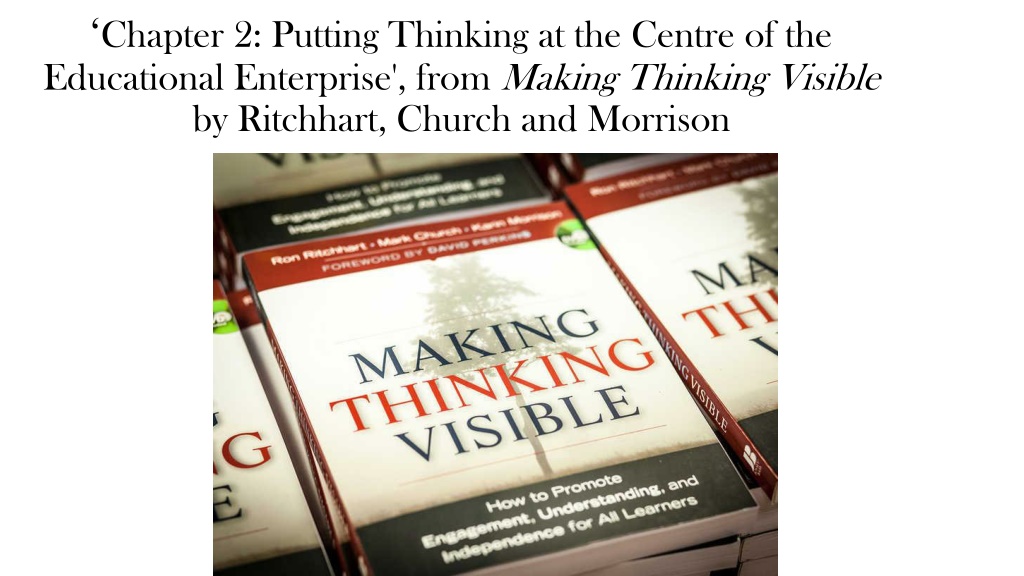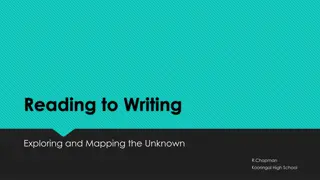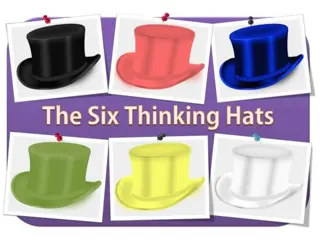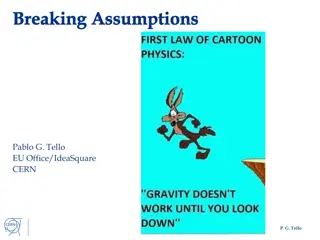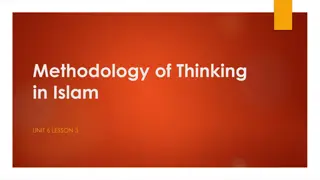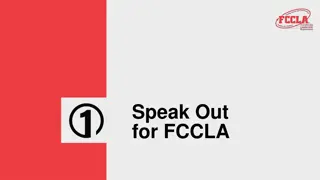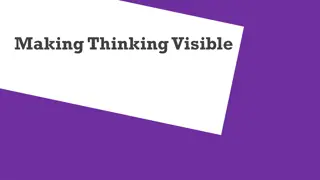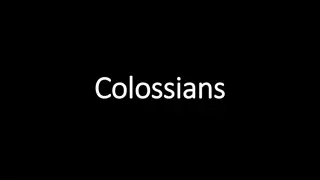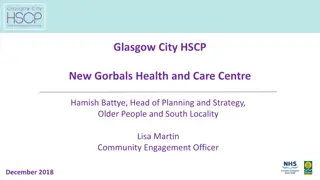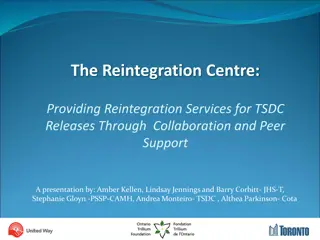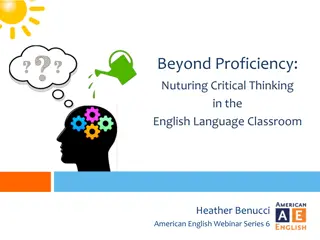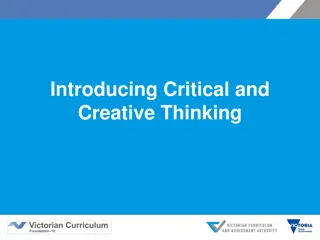Putting Thinking at the Centre of Education
This content discusses the importance of placing thinking at the core of the educational process. It explores the roles of students and teachers, rethinking traditional educational models, and promoting active learning through visible thinking. The authors delve into strategies for making thinking visible and enhancing student engagement with ideas. By prioritizing deep thinking, students can develop lasting learning skills that go beyond mere absorption of information.
Download Presentation

Please find below an Image/Link to download the presentation.
The content on the website is provided AS IS for your information and personal use only. It may not be sold, licensed, or shared on other websites without obtaining consent from the author.If you encounter any issues during the download, it is possible that the publisher has removed the file from their server.
You are allowed to download the files provided on this website for personal or commercial use, subject to the condition that they are used lawfully. All files are the property of their respective owners.
The content on the website is provided AS IS for your information and personal use only. It may not be sold, licensed, or shared on other websites without obtaining consent from the author.
E N D
Presentation Transcript
Chapter 2: Putting Thinking at the Centre of the Educational Enterprise', from Making Thinking Visible by Ritchhart, Church and Morrison
The writers Ritchhart: investigator at Project Zero, Harvard Graduate School of Education and author of books about thinking, previously a classroom teacher Church: classroom teacher and consultant for Project Zero Morrison: director of the Development Centre at Independent Schools Victoria (ISV) and faculty member at Project Zero Summer Insititutes
Context within the book Part One Some Thinking About Thinking ONE Unpacking Thinking Interesting student mind maps with their thought processes illuminated (TWO Putting Thinking at the Centre of the Educational Enterprise) Part Two Using Thinking Routines to Make Thinking Visible I like Zoom In and Circle of Viewpoints I Used to Think ., Now I Think (but I change to present tense/ongoing) Part Three Bringing the Power of Visible Thinking to Life Professional Learning: teachers as thinkers and learners, and some case studies
The narrative Role of student and teacher Thinking and learning and teaching and thinking and learning and teaching and Listening Visibility: Modelling Naming Questioning Documenting My Thinking: applications for English teaching
Re-thinking traditional roles The Role of Student and Teacher The Role of Student and Teacher Traditional models of learning cast the learner in a passive role, taking in what is being delivered. Assessments focus on the degree of absorption When we place the learner at the centre, the role of teachers shifts from delivery of information to fostering students engagement with ideas.
Thinking and Learning Our goal Our goal must be to make the big ideas of the curriculum accessible and engaging while honouring their complexity, beauty and power in the process. When there is something important and worthwhile to think about and a reason to think deeply, our students experience the kind of learning that has a lasting impact; they not only learn, they learn how to learn. Learning occurs as a result of our thinking and active sense making. Learning is a consequence of thinking. Far from thinking coming after knowledge, knowledge comes on the coattails of thinking.
Visibility for learning and teaching We need a window into what students understand, and also how they are understanding it We can design experiences to advance their understanding. For example, exposing their thinking and pushing it forward through discrepant and unexpected events. Allow students nascent theories to be the object of continual discussion, justification and refinement. When we demystify the thinking and learning process, we provide models for students of what it means to engage with ideas, to think and to learn. We show them that school is not about the quick right answer , but is about the ongoing mental work of understanding new ideas and information.
Modelling Thinking Children grow into the intellectual life of those around them. (Vygotsky 1978) The novice imitates experts in an ever-advancing series of approximations of excellence. Consequently, the students in our charge need to see an image of us as thinkers and learners that they can imitate and learn from. They need to see others perspectives, insights, and questions as they advance in their own understanding. Students need to see how others plan, monitor, and challenge their own thinking in ways that move them forward. Students need to see that all learners make mistakes and that learning often occurs from reflecting on those mistakes. (my example - planning an essay collaboratively in English)
Making the invisible visible: thinking aloud The Role of Language in Shaping Learning The Role of Language in Shaping Learning The more a learner is enabled to think aloud, the more he or she can take responsibility for formulating explanatory hypotheses and evaluating them. (Barnes, 1976) The importance of verb choices (SER) I think or I thought becomes I am thinking, I continue to think, I am formulating an opinion, I am considering, I am wondering, I am contemplating Allowing minds to change: I was wondering .. But now I am considering .
Expressions for thinking processes Teachers must help students to recognise the key features and contexts for the use of various types of thinking. We should name, notice and highlight thinking when it occurs in class: recognising a student who puts forth a new point of view, offers up a nascent theory or conjecture, proposes an explanation, makes a connection, sees a pattern, and so on. Until students can name a process they cannot control it (Keene 1997) We must first spot opportunities for thinking; only then can we activate our abilities. When we make the thinking that happens in classrooms visible, it becomes more concrete and real. It becomes something we can talk about and explore, push around, challenge and learn from. We can name and notice students thinking as a way of providing specific feedback on learning rather than generic praise (idea - could there be a great thinking praise point?) Example - I like how you have used your prior knowledge and what you already know to really build explanations of what is going on in these photographs We need to provide a clear picture of the thinking they have done and a reference point they can draw on in their future learning.
Making the invisible visible: questions Open-ended questions Blooms taxonomy as a template to build questions Questions which 1.) model our interest in the ideas being explored. 2.) help students to construct understanding, and 3.) facilitate the illumination of students own thinking to themselves. Ask authentic questions (questions which the teacher does not already know the answer to) and create a classroom culture that feels intellectually engaging. This allows students to see teachers as learners and fosters a community of inquiry. (IB) Good essential questions can be useful too. For example, a set of essential questions to focus students on the fundamental issues at the heart of a subject, such as truth, perspective and universality in history and literature. (see examples on the classroom wall). Students own authentic questions are a good measure of their intellectual engagement. (A good plenary : come up with a question about the character, topic of the lesson) Questions = assessment for learning. Through students questions we get a glimpse into their thinking: What issues are engaging them? Where is there confusion? Where and how are they making connections? Where are they seeking clarification? This often creates a ripple effect in the classroom of excitement and energy needed for learning.
Making the invisible visible: questions Constructive questions are those that help to advance understanding; connect ideas, make interpretations, focus on big ideas and central concepts, extend ideas and so on. To guide, direct, push forward students understanding of important ideas. Example: what does your feeling/reading/viewing of it make you wonder? Facilitating and Clarifying Thinking Facilitating and Clarifying Thinking What makes you say that? This is one of the most successfully integrated thinking routines because it invites you to elaborate on and clarify ideas in a nonthreatening way. In using facilitative questions, the teacher s goal is to try and understand students thinking, to get inside their heads and make their thinking visible. The reflective toss model of sequencing questions involved follow-up questions to grasp meaning, for example, can you say what you were thinking in a different way? and then questions which push the student to further elaborate and justify their thinking, to the teacher and to themselves. For example, what does that tell you then? These questions and question sequences facilitate students clarifying their own thinking and ideas in such a way that new understanding is developed that the student owns.
Making the invisible visible: documenting Documentation can help make thinking visible; it can demystify the learning process. The process and discussion should be documented, not merely the finished product . It must serve to advance learning, not merely capture it. To capture and record students thinking, teachers must be vigilant observers and listeners. When teachers capture students ideas, they are signalling that those ideas and thoughts have value. Documenting an ongoing process allows all group members to access the learning of the group and feel a sense of ownership. The documentation also allowed the group to monitor progress, make contributions and ask questions (sticky notes, google docs). Sharing documentation of thinking with colleagues can lead to rich discussions of learning. Conclusion: As teachers, we aim to engage students actively with ideas, and uncover and Conclusion: As teachers, we aim to engage students actively with ideas, and uncover and guide their thinking about those ideas. We aim to make students thinking visible through guide their thinking about those ideas. We aim to make students thinking visible through our questioning, listening and documenting so that we can build on and extend that our questioning, listening and documenting so that we can build on and extend that thinking on the way to deeper and richer understanding. thinking on the way to deeper and richer understanding.
Listening A Pedagogy of Listening A Pedagogy of Listening Listening - taking a vigorous, human interest in what is being told. This vigorous human interest allows us to build a learning community and develop interactions that pivot around the exploration of ideas. (how can we show that we are listening?) It is one thing to ask good questions, but one also has to listen for the answers. Good questions that drive learning don t come from a prescribed list, they arise in response to students contributions. Listening must be the basis of the learning relationship that teachers seek to form with students. Listening conveys a sense of respect for and an interest in the learner s contributions. As teachers, our listening to students provides a model for our students of what it means to listen. In classrooms where teachers routinely ask, what makes you say that? , students soon pick this up as an appropriate and useful way to respond to one another s contributions. Students learn to really collaborate, to listen and respond to one another s ideas and to ask clarifying and probing questions of one another.
My thinking How can I communicate the importance of thinking to students? How can I help students to realise that thinking is an ongoing and ever-changing process? How can I encourage students to move from the passive model of absorbers of knowledge to active thinkers, overcoming their nerves regarding pressures such as exams and peers? What names can I give to the different types of thinking? How can we assess the learning that comes from thinking? How can we empower students to experiment with thinking? How can I share my own thinking and learning with students in an authentic way? How can I foster genuine listening? Longer term thoughts: Longer term thoughts: Could we devise a whole-school language of thinking , to enable students to learn consistent terms for thinking? Can we connect mindfulness, healthy minds and thinking initiatives? Should there be a great thinking praise point? Can we use the start of the IB to launch a community of inquiry to include sixth form and whole school?
Universal Questions for Literature What is the story? What is the story? Thinking about narrative, tradition and genre DESCRIBE Whose voice tells the story? Whose voice tells the story? Thinking about character, narrator and style ANALYSE Why is the story told? Why is the story told? Thinking about purpose, audience and motivation EVALUATE What is the other story? What is the other story? Thinking about choices of the writer and narrator, omissions, characters who might be silent and why, selective recount HYPOTHESISE What does the story reveal about being human? What does the story reveal about being human? Thinking about the deeper meaning of the story for readers, ideas about timelessness, story as symbol and a product of the world in which it is created RELATE AND ENGAGE
Main threads of the Journal Club discussion follow
Main threads of our meeting Modelling including the modelling of rubbing things out, improving on things (link to the idea of Growth Mindset ). The idea of re-reading something leading to rethinking appears alien to some pupils. Tension between wanting students to engage with ideas in the way they wish versus students having to jump through prescribed exam hoops the temptation to condense things into lists. Encouraging pupils to think aloud I think I am wondering I am considering I am contemplating . Plenary idea I was wondering, but now I am considering making the changes of mind more explicit Naming this can be problematic, e.g. Blooms Taxonomy. We discussed the importance of giving students a language so that they can talk about their thinking. Demystify the process of thinking so that it s not seen as a problem to not have an (or the ) answer. Until pupils can name a process they cannot control it. Questioning keep them open-ended; essential questions to focus on fundamental issues place these around the classroom? A reminder about the importance of Assessment for Learning questions. What makes you say that? can be very powerful to help pupils think about their thinking. This invites pupils to share their thoughts in a non-threatening way.
Main threads of our meeting Documenting how do we assess thinking? Can we have a thinking praise point? There was a lot of appreciation among journal club members for Mr G s gems when Aruna teaches PRE: praising thinking rather than great answer . Compare documentation versus celebration: looking for pupils work being a process rather than a neat piece of work. Pupils need to engage rather than copy from the board. Listening: Listening isn t waiting to speak listening is a really difficult skill; importance of building listening communities and accepting that pupils find this hard Thinking and examination: Thinking isn t praised in examination so pupils have a tendency to go straight in. Perhaps pupils need explicit training and even directed thinking time. Distinguish between questions that need time for thinking and questions that can be answered straight away. How do we impose our own thinking pathways on other students? Are we allowing pupils to form their own pathways and thought patterns? We discussed Kitty White s treasure hunt / problem solving activity where the thinking comes first
